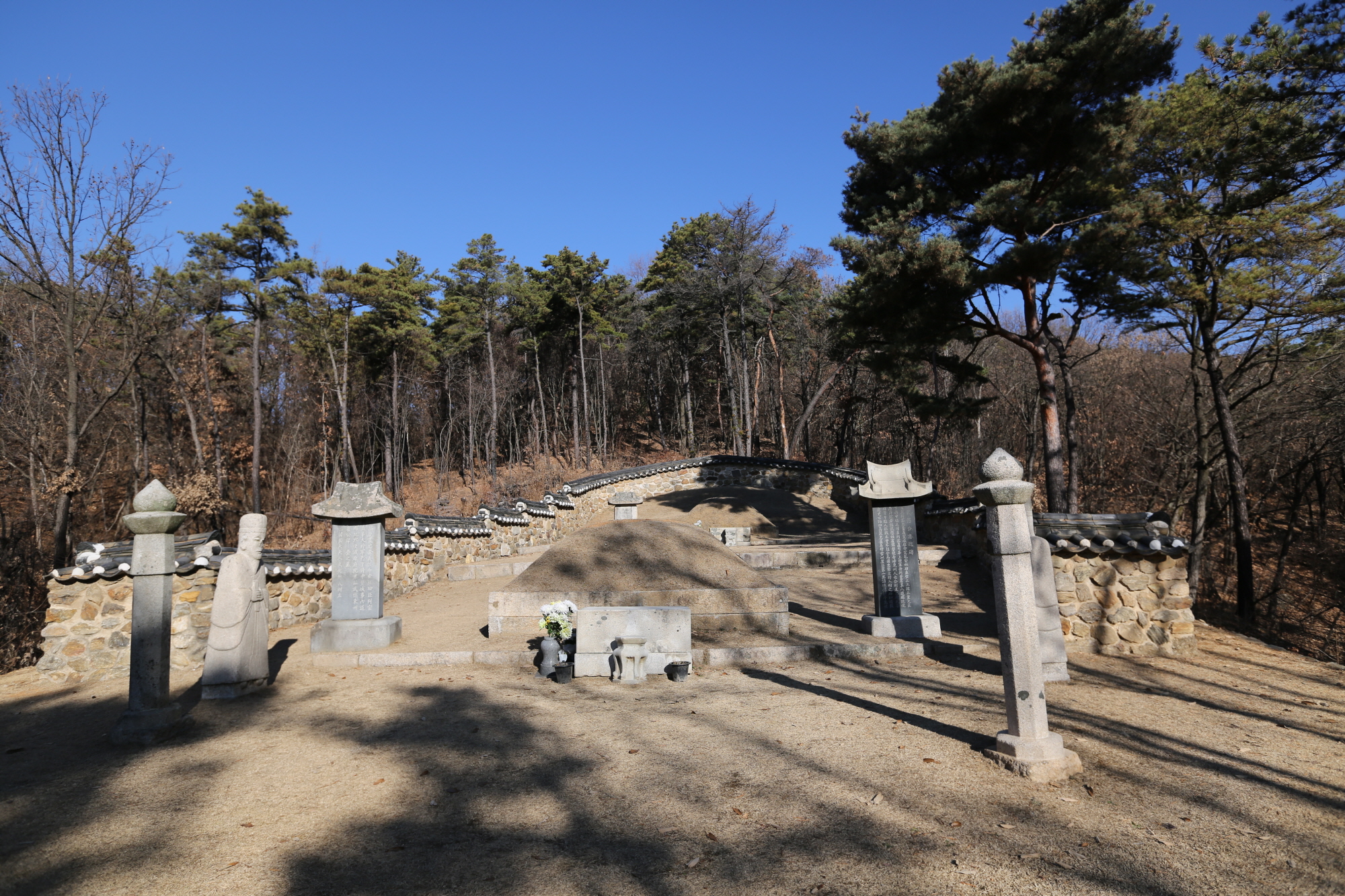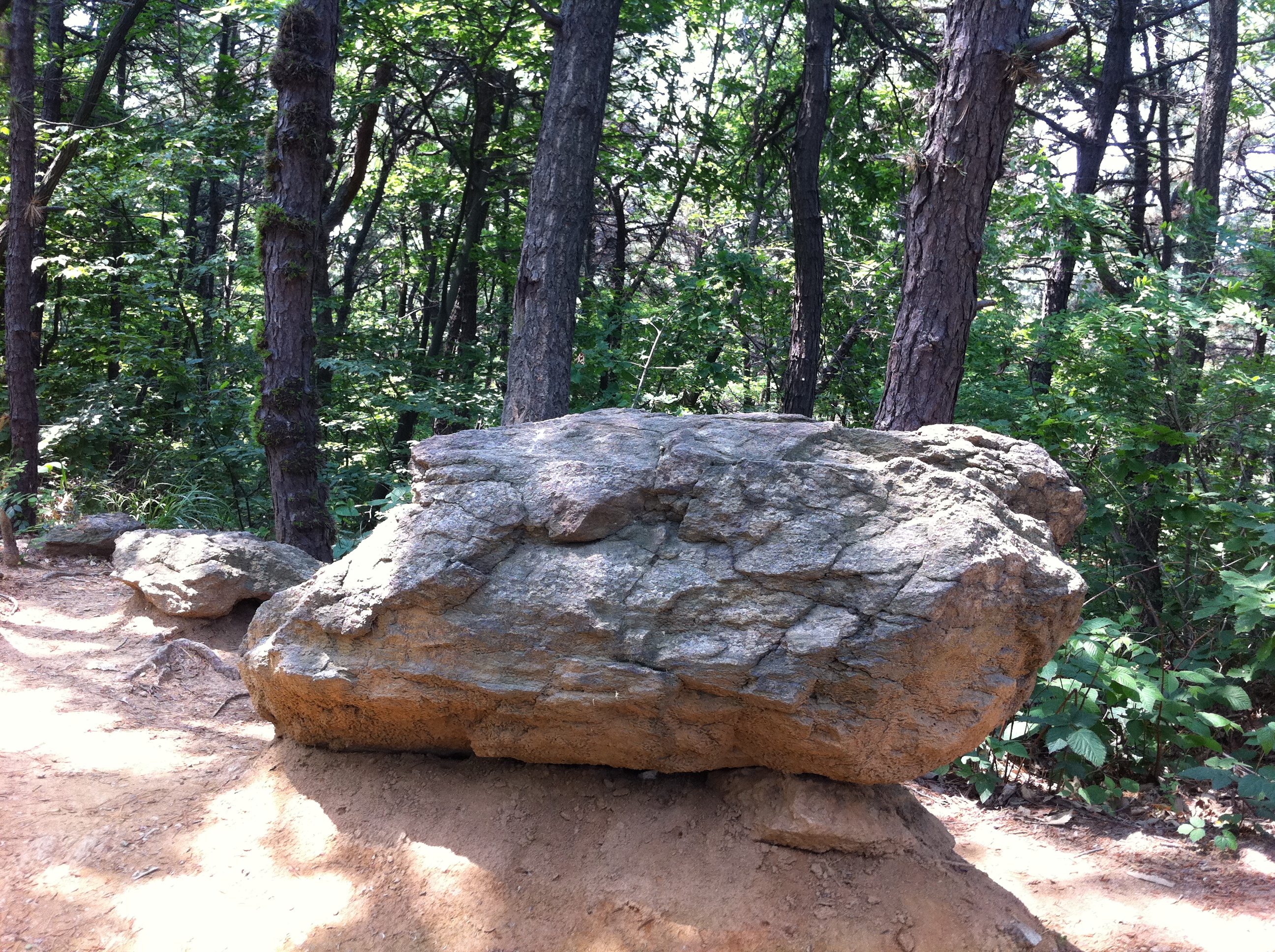
Daeja-dong village of Deogyang-gu that derived its name from the tomb of Seongnyeong Daegun, brother of the Great King Sejong
Daeja-dong, located northeast of Jugyo-dong where the Goyang City Hall is located. Its administrative district is Gwansan-dong, it is Beopjeong-dong village that is part of Goyang-dong.
There is monument of Philippines’s participation of the Korean War and Taeguekki Park.
Following the Daeyang-ro for 1.5Km that stretches from Tong-gil-ro to Daeja-dong, there are tomb of General Choe Yong and the right and tomb of Seongnyeong Daegun on the left.
The tomb of Seongnyeong Daegun is designated as Goyang Regional Cultural Asset and has a shrine of the Great Lion and next to the shrine stands a monumental stone of Seongnyeong Daegun that was built in the early Joseon period.
Seongnyeong Daegun is the fourth brother of the Great King Taejong, who was a biological younger brother of the Great King Sejong. As the younger son, he was muched loved by his parents but died at the early age of 13 from an illness.
His wife, Lady Seong from Changnyung, adopted Anpyeong Daegun, King Sejong’s brother, as she had no children. But Anpeyong Daegun also dies during the Coup d’Etat of Kye-yu.
King Taejong and his queen who saw the death of their youngest son built a tomb and shrine in Daeja-dong to console his spirit.
At 100m to the south of the tomb, they built a sanctuary to perform rituals for the dead and called it Daejasa, a place of great love.
Many monks lived here to pray for Seongnyeong Daegun’s easy passenger into eternity and Buddhist merits.
Daejasa thus became a big temple that represents Korea. Afterward, the town came to be called Daeja.
There are many tombs of the royal families in Daeja Valley and Daeja-dong, and tombs of over 30 famous figures remain in Daeja-dong.
![Memorial Month of June, unknown soldiers who died protecting Goyang]()
Memorial Month of June, unknown soldiers who died protecting Goyang
The Gyeongsang region, which started in 1950 and was linked to the North Korean War, the Unification Road and the Gyeongui Line, has been affected greatly.
In the Korean War that began in 1950, Goyang region experienced great damages as it connects to the north with Tong-il Road and Kyeongye Line.
With Kaesong at a close distance, the possession switched over many times with 1.4 Retreats and many residents suffered great damages.
Because it is close to Kaesong, and after 1.4 retreats, several owners changed, and many residents suffered great damage.
During this process, bodies of young and unknown warriors were scattered throughout Goyang City, buried in the forests under the trees without having found their parents.
In recent years, more than 20 bodies have been unearthed in the course of collecting the dead as a project of the Ministry of National Defense.
They are speculated to be the remains of the Korean army soldiers who lost their lives while fighting against the enemy who were marching from the direction of Paju Bogwang Temple toward Goyang-dong, Goyang-si.
Young soldiers who have not returned to their families for more than 60 years have been buried with guns, guns, and other items.
The remains of a number of soldiers who cannot be identified because they do not have the chains with military serial number .. The excavation will start the work to find their relatives.
Many of the soldiers who sacrificed for the country have not been unearthed in our city, and still seem to be asleep under the forest.
The remains have been unearthed in Gobong Mountain, Daeja Mountain, and Bakdal Mountain, and many more are expected to be discovered in the future.
In light of the memorial month of June, we told the story of the unknown fallen warriors of the Korean War.
![Story of Yeoseokryeong, Sutdol Gogae of Samsong-dong]()
Story of Yeoseokryeong, Sutdol Gogae of Samsong-dong
There is a famous ridge, also called Sutdol Gogae(Ridge) between Ogeum-dong and Samsong-dong of Goyang City where the Tong-Il-ro passes.
The national road No 1 Tong-Il-ro that now connects north to south passes through the peak of the ridge. The area nearby the ridge used to be an ordinary farming town, and recently a large-size apartment complex was constructed.
The reason why this ridge is called Sutdol Gogae has a deep relationship with the Baekjegwan Battle that occurred on January 27th, 1593.
It was famous battle between the Japanese and Ming soldiers that lead the fortune of the Japanese Invasion of 1592.
The first battlefield of this fought happened in Sutdol Gogae.
Tens of thousands of Ming soldiers led by General Li Rusong were ambushed by the Japanese soldiers at Sutdol Gogae.
Ming soldiers that defeated the Japanese soldiers at the Pyeongyang Castle Battle with strong firepower were greatly defeated by the Japanese soldiers at Sutdol Gogae.
General Li Rusong himself barely escaped with just his life thanks to the sacrifice of his subordinate and retreated to Kaeseong, passing Paju
After two weeks, the Japanese army is defeated at the Victory of Haengju by General Kwon Yul, leaving Hanyang Castle and completely retreating to the southern regions.
As the Japanese army retreats from Hanyang Castle, Li Rusong and the Ming army marches through Sutdol Gogae.
At this time, General Li Rusong thought of his men who passed away at Sutdol Gogae and grinded his blade against a stone, pledging to revenge for them.
This is how the ridge got its name of Sutdol Gogae, which translates to Yeoseokryeong in Chinese characters.
On either side of Sutdol Gogae are Hanbook Nuri-gil and Seosamreung Nuri-gil, which many people are enjoying today.
The stone that is said to be used to grind General Li’s blade is now gone from the Tong-Il-ro expansion project. But the townspeople still call this ridge Sutdol Gogae and holds festivals. As some historians claim that the Baekjegwan Battle should be called Sutdol Gogae Battle instead, the ridge is significant in the history of the Japanese Invasion of 1592.
![Story of Gwoegapsu, the gingko tree in Goyang-dong]()
Story of Gwoegapsu, the gingko tree in Goyang-dong
There is a 600-year-old ginkgo tree at about 100m west of the Baekjaegwanji, Goyang-dong, Goyang City.
It is a famous tree that have been managed and designated as a protected tree now.
There is a guide about the free on the scene.
It was recorded that a governor planted the tree at the time when the Goyang County Office near this tree.
It is one tree but with two large branches, it appears as two trees.
The tree is very large, 15m n height and 6m in width.
Nearby residents call this gingko tree Gwoegapsu.
During the time of the Japanese Invasion of 1593, there was a battle of Baekjegwan in the area of Goyang-dong, Baekje-dong, and Daeja-dong.
The Ming army lead of Ri Lusong and the Japanese soldiers had the greatest battle of the time and the Ming soldiers is defeated by the Japanese who attacked in ambush at the Sutdol Gogae (Ridge), and this battle is called the Baejkegwan Battle.
The Japanese general that defeated the large army of Ming soldiers hung his armor and helmet on the gingko tree to boat of his victory, giving the tree the nickname of Gwoegapsu.
It still carries good fruits and has healthy energy.
The townsmen people use the place as a field education place through programs like “A Round of Our Town”. The gingko tree in Goyang-dong is a famous tree with stories.
![Story of Songhang Village]()
Story of Songhang Village
Songgang Village is an old village near Gongreung River in Sinwon-dong, Deogyang-gu, Goyang-si. It is a small town where about 15 families live now.
Calling this place Songkang Village is deeply related to Jeong Cheol of Songgang, who is famous for being a politician, literary man and poet in the mid Joseon Dynasty.
Sir Songgang stayed here for the mourning of his parents' passing and many times during his lifetime. Even now, there are the Songgang Literary Museum and the mausoleums of parents and brothers of Songgang.
Right behind the literary museum, there remains a grave of a righteous gisaeng (female artist) named Kang-ah.
In fact, the mausoleum of Sir Songgang was also here, and now it has moved to Jincheon, Chinbuk by Sir Uam Siyeol Song.
At the entrance to the Songgang village, there are ten monuments bearing Songgang's poems and his activities in the Songgang Village.
Every year, with the support of Goyang City, the Songgang Culture Festival is held under the supervision of the Goyang City Native Culture Preservation Society.
![Story of Paleolithic Remains of Tanhyeon-dong, Goyang City’s first town]()
Story of Paleolithic Remains of Tanhyeon-dong, Goyang City’s first town
In October 2017, ruins that would go down in history were excavated in Tanhyeon-dong, Ilsan Seo-gu, located in northwestern part of Goyang City.
In the process of researching the buried cultural assets to build large-size apartment complex, 307 artifacts from 50 thousand to 65 thousand years ago were excavated.
The Cultural Heritage Administration implemented detail researches and stone tools, pricker, attractor, etc were found.
The artifacts that were found during this period were moved to National Museum of Korea and some are stored by the excavation agency.
In January of 2016, 228 artifacts from mid-stone age and Joseon Dynasty were newly excavated during the apartment construction near the Korea Archeology & Art History Research Institute.
These two locations are the decisive ruins with the oldest artifacts in the Goyang region that have brought forth the history of the city to the Paleolithic Era.
More artifacts continue to be excavated in this place, located at the foot of Hwangryong Mountain and Gobong Mountain, along with other areas such as Paju and Gimpo.
Pit-dwelling ruins are also found, increasing its historical value.
This excavation of Paleolithic ruins did not end as a simple excavation research but a report of excavation research of cultural assets that recorded the results of the excavation has been published.
The new findings of Paleolithic ruins in Tanhyeon-dong is an important incident that rewrites the history of Goyang City.

March 23rd is the birthday of Goyang City
March 23rd is the birthday of Goyang City
The birthday of Goyang city, where a population of 1.04 million people live, is March 23rd. The name Goyang was first termed 604 years ago, in the 13th year of Taejong's Joseon (1413) after “Go” of Gobonghyun and “Yang” of Deogyanghyun. The pure Korean version of Goyang is nopbiti. Goyang City is a historic name that has not changed its name since the creation of the name Goyang, which continues to be used today.
Goyang-dong, Goyang Bridge, Goyang Elementary School, etc. are all names that have been used for over 100 years.
On March 23, 2013, Goyang City restored Sanyoungru, Yeongsajeong, and other cultural assets in the broadscale "Goyang 600 Years Project" to celebrate the 600th birthday of Goyang City.
Let's celebrate Goyang City's birthday on March 23rd.

Enjoy Guksabong Dolmen with Goyang’s nurigil
Enjoy Guksabong Dolmen with Goyang’s nurigil
Haengjunuri-gil is the road that begins at Wondang train station of Goyang and continues to Haengjus Mountain Fortress.
The highest mountaintop during this nuri-gil is Seongra Mountain’s Guksabong.
At the foot of Guksabong, 200m to the west of the Seongra Mountain mineral spring, remains dolmen.
Stone blades were found near this dolmen, which is now stored at the Seoul University’s museum.
The cover stone of this dolmen was placed on land and the footstone was underground, which made is difficult to see with bear eyes.
Guksabong’s Dolmen have significant cultural and historical value in that it shows of Goyang’s cultural heritage of the Bronze Age.
There is also Jireong Mountain Dolmen within Haengjunuri-gil, which has been designated and protected as a Goyang Regional Cultural Asset for its beautiful shape, old age, and unique features.


